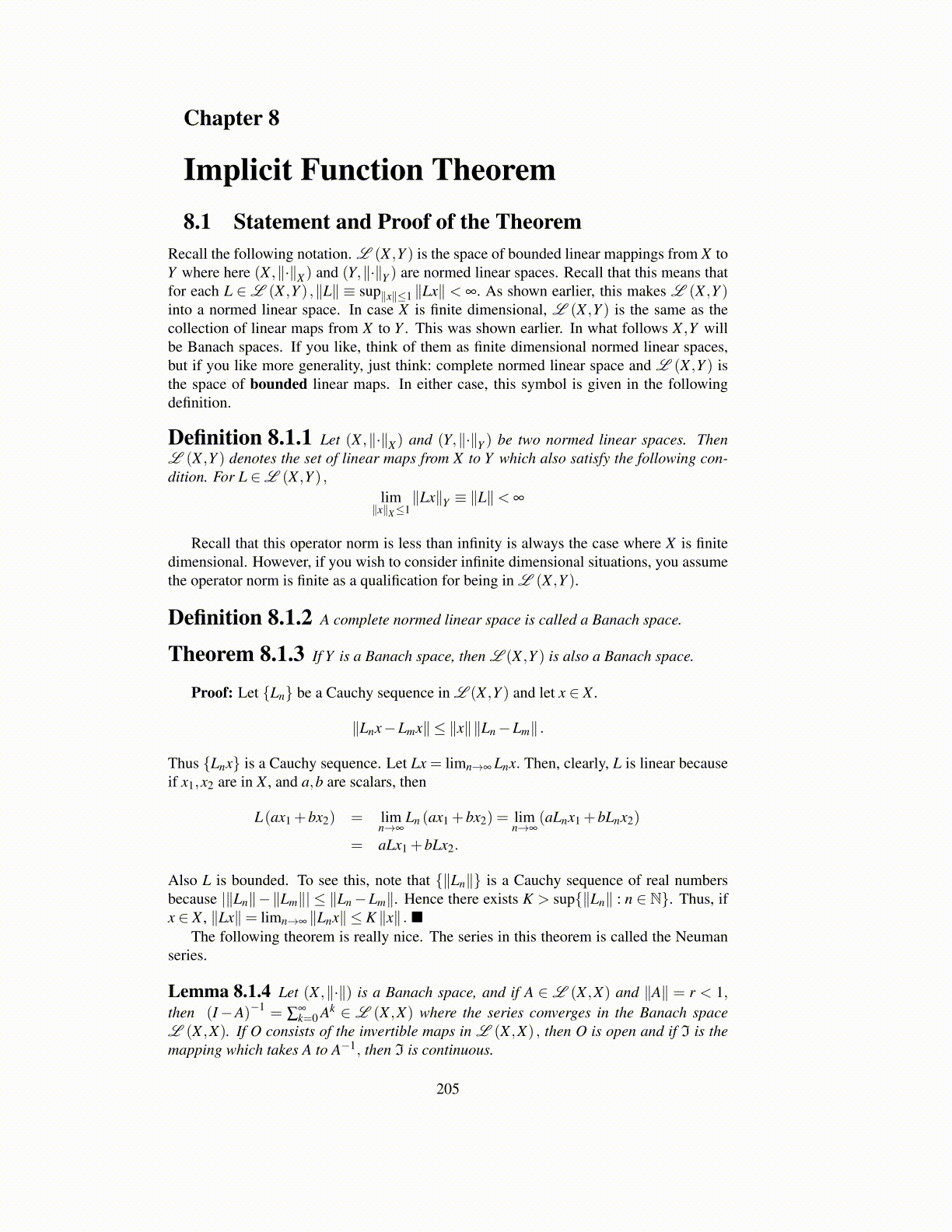
Chapter 8
Implicit Function Theorem8.1 Statement and Proof of the Theorem
Recall the following notation. L (X ,Y ) is the space of bounded linear mappings from X toY where here (X ,∥·∥X ) and (Y,∥·∥Y ) are normed linear spaces. Recall that this means thatfor each L ∈L (X ,Y ) ,∥L∥ ≡ sup∥x∥≤1 ∥Lx∥ < ∞. As shown earlier, this makes L (X ,Y )into a normed linear space. In case X is finite dimensional, L (X ,Y ) is the same as thecollection of linear maps from X to Y . This was shown earlier. In what follows X ,Y willbe Banach spaces. If you like, think of them as finite dimensional normed linear spaces,but if you like more generality, just think: complete normed linear space and L (X ,Y ) isthe space of bounded linear maps. In either case, this symbol is given in the followingdefinition.
Definition 8.1.1 Let (X ,∥·∥X ) and (Y,∥·∥Y ) be two normed linear spaces. ThenL (X ,Y ) denotes the set of linear maps from X to Y which also satisfy the following con-dition. For L ∈L (X ,Y ) ,
lim∥x∥X≤1
∥Lx∥Y ≡ ∥L∥< ∞
Recall that this operator norm is less than infinity is always the case where X is finitedimensional. However, if you wish to consider infinite dimensional situations, you assumethe operator norm is finite as a qualification for being in L (X ,Y ).
Definition 8.1.2 A complete normed linear space is called a Banach space.
Theorem 8.1.3 If Y is a Banach space, then L (X ,Y ) is also a Banach space.
Proof: Let {Ln} be a Cauchy sequence in L (X ,Y ) and let x ∈ X .
∥Lnx−Lmx∥ ≤ ∥x∥∥Ln−Lm∥ .
Thus {Lnx} is a Cauchy sequence. Let Lx = limn→∞ Lnx. Then, clearly, L is linear becauseif x1,x2 are in X , and a,b are scalars, then
L(ax1 +bx2) = limn→∞
Ln (ax1 +bx2) = limn→∞
(aLnx1 +bLnx2)
= aLx1 +bLx2.
Also L is bounded. To see this, note that {∥Ln∥} is a Cauchy sequence of real numbersbecause |∥Ln∥−∥Lm∥| ≤ ∥Ln−Lm∥. Hence there exists K > sup{∥Ln∥ : n ∈ N}. Thus, ifx ∈ X , ∥Lx∥= limn→∞ ∥Lnx∥ ≤ K ∥x∥ . ■
The following theorem is really nice. The series in this theorem is called the Neumanseries.
Lemma 8.1.4 Let (X ,∥·∥) is a Banach space, and if A ∈ L (X ,X) and ∥A∥ = r < 1,then (I−A)−1 = ∑
∞k=0 Ak ∈ L (X ,X) where the series converges in the Banach space
L (X ,X). If O consists of the invertible maps in L (X ,X) , then O is open and if I is themapping which takes A to A−1, then I is continuous.
205